The story behind the universal stripes of the Buddhist flag

The Buddhist flag is a common sight in Buddhist communities today, often seen hanging from temple ceilings or columns indoors, or flying high from flagpoles.
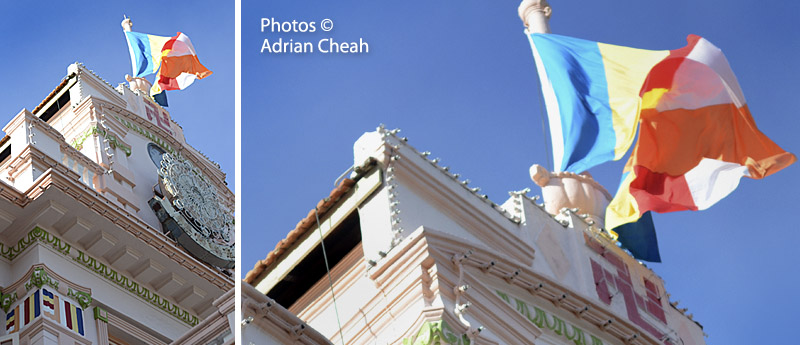
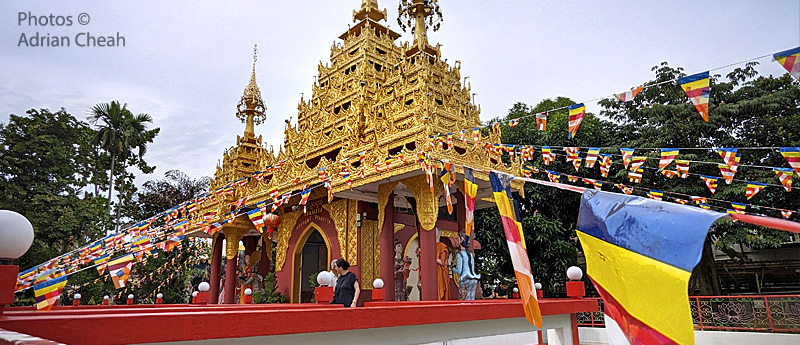
In Penang, during Vesak Day, the Penang Buddhist Association along Jalan Anson, as well as Buddhist temples throughout the state decorate their premises with strings of Buddhist flags and streamers, raised high to sway in the breeze. Placing them high allows them to catch the wind, believed to carry positive spiritual vibrations where prayers are carried by the wind. Placing them high allows them to catch the wind, believed to carry positive spiritual vibrations where prayers are carried by the wind.
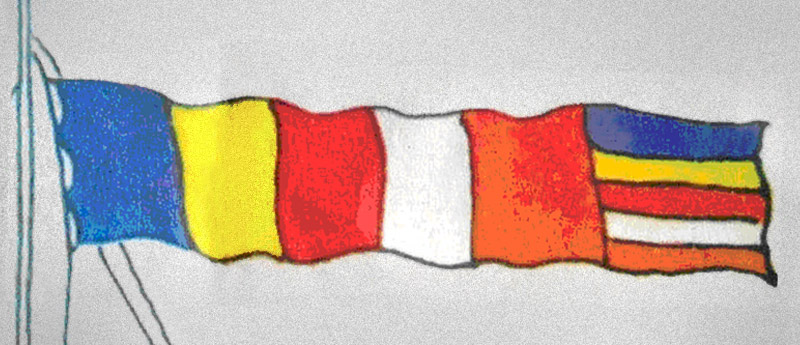
The initial design of the Buddhist flag (source: www.dinamina.lk)
The Buddhist flag, though now a universal symbol of the Buddhist world, is a relatively modern creation. It was first raised in Colombo (now Sri Lanka) on Vesak Day on 28 April 1885 by Ven. Migettuwatte Gunananda Thera at Deepaduththaramaya in Kotahena. This event occurred during a period when the country was under British colonial rule and remarkably, that day was declared a public holiday for the first time. Previously, the Dutch had abolished the Vesak Poya holiday in 1770 and despite requests, the British had also disregarded calls for its restoration until 1885.
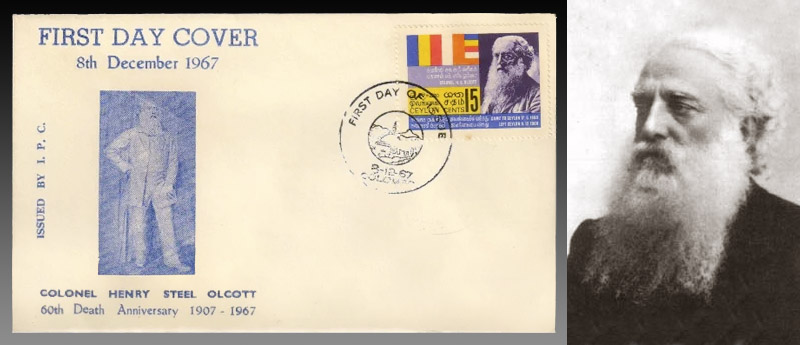
First Day Cover of Colonel Olcott and Buddhist flag, Ceylon, 1967; Right: Henry Steele Olcott (public domain).
An American author, journalist, attorney, philosopher and cofounder and inaugural president of the Theosophical Society, Colonel Henry Steele Olcott (1832–1907), played a pivotal role in assisting Buddhist leaders to establish the Buddhist Defence Committee in Colombo. He also laid the groundwork for the development of the Buddhist flag by mobilising human resources. Additionally, in 1880 he established the Buddhist Publications Fund, which facilitated the printing of the Sinhalese newspaper Sarasavi Sandaresa, translated to English as "The Ray of Words". This newspaper provided a platform for Ceylonese Buddhists to express their voices and perspectives.
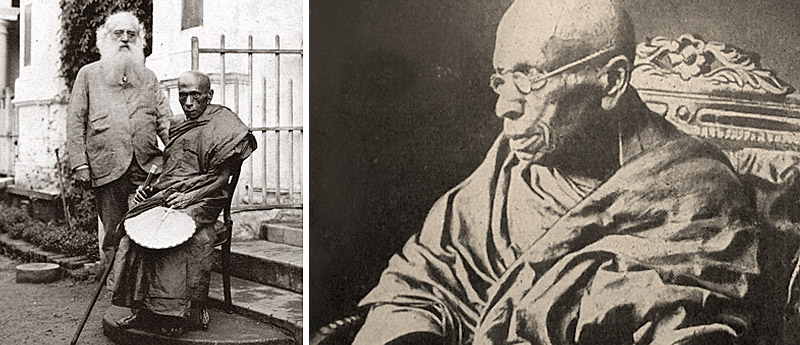
Left: Ven. Hikkaduwe Sri Sumangala Thera and Colonel Henry Steel Olcott in Colombo, 1889 (public domain).
In 1885, the Colombo Committee, spearheaded by Ven. Hikkaduwe Sri Sumangala Thera, formulated the concept of creating a Buddhist flag as part of their arrangements for the Vesak event. Colonel Olcott was joined in as an honorary member. The primary objective of the committee was to establish the flag as a symbol of unity for Buddhists worldwide.

Left: Carolis Pujitha Gunawardena. Right: Masthead of the Sarasavi Sandaresa newspaper.
Carolis Pujitha Gunawardena (1854–1926) is credited as the designer of the flag, which made its debut in print in the Sarasavi Sandaresa on 17 April 1885. The design of the six-coloured flag was adopted in March 1885 by the Colombo Committee, chaired by the Sri Lankan monk, Ven. Hikkaduwe Sri Sumangala Thero. The flag, fashioned as a long streaming pennant, symbolised unity among Buddhists worldwide. Gunawardena served as the secretary to both the Buddhist Defence Committee (1884) and the Colombo Committee (1885), showcasing his pivotal role in these endeavours. At the time, he was around 30 years old, marking him as one of the few younger members of the commission.
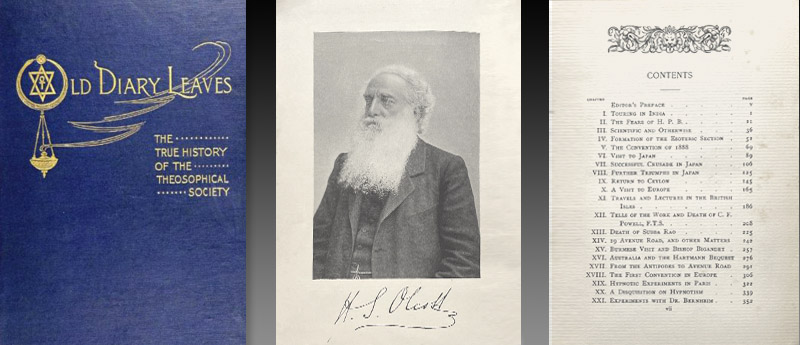
Colonel Olcott, in his "Old Diary Leaves", made the following observation: “It was at this time that our Colombo colleagues had the happy thought of devising a flag which would be adopted by all Buddhist nations as the universal symbol of their faith, thus serving the same purpose as that of the cross does for all Christians. It was a splendid idea, and I saw in a moment its far-reaching potentialities as an agent in that scheme of Buddhist unity. Our Colombo brothers had hit upon the quite original and unique idea of blending in the flag the six colours alleged to have been exhibited in the aura of the Buddha.”
Colonel Olcott noted in his diary that he did not design the Buddhist flag but rather contributed to modifying its shape. Additionally, in the Centenary volume of the Buddhist Theosophical Society, founded by himself, credit is given to Gunawardena as the designer of the Buddhist flag.
In 1886, Colonel Olcott expressed his concern that the initial long design of the flag, as envisioned by the Colombo Committee, resembled a ship's long, streaming pennant, which he deemed inconvenient for processions or indoor decorations.
“As the Colombo Committee had sketched the flag, it was of the inconvenient shape of a ship’s long, streaming pennant, which would be quite unsuitable for carrying in processions or fixing in rooms.” – Henry Steel Olcott, “Old Diary Leaves” (Chapter XXV. Establishing A Buddhist Flag), p 351–352.
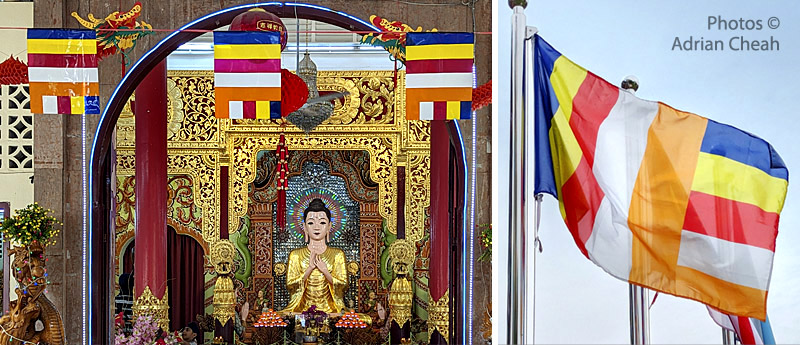
Therefore, he proposed to modify the shape of the Buddhist flag to align with the standard size of national flags.
“My suggestion that it should be made of the usual shape and size of national flags was adopted, and when we had a sample made, it was unanimously approved of.” – Henry Steel Olcott, “Old Diary Leaves” (Chapter XXV. Establishing A Buddhist Flag), p. 352.
“Miss Müller is in error in saying that I devised the Buddhist flag; the credit for this goes to the members of the Colombo T. S. Of course I was consulted after the colors were chosen, and all I did was to prescribe the shape in which the flag should be made.” – Henry Steel Olcott, “Old Diary Leaves” (Chapter XXVII. Buddhist Ceremony At Darjeeling).
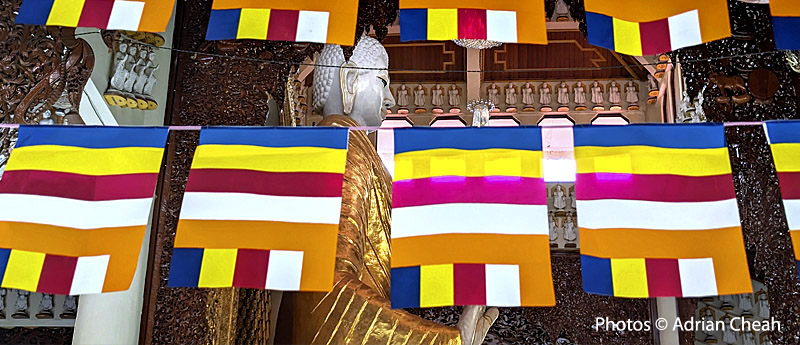
In the same year, on 8 April, the modified flag was published in the Sarasavi Sandaresa newspaper. The amended Buddhist flag – the one we commonly see today – was unveiled in Japan in 1889.
When Colonel Olcott first arrived in Colombo, his initial goal was simply to delve deeper into the Eastern religions he admired. However, this Presbyterian-born Spiritualist found himself embracing Buddhism and sparking a revival that would resonate throughout the entire Buddhist world. He actively promoted Buddhist education, leading to the establishment of three colleges and around 250 schools in Colombo (according to britannica.com). Upon his passing in 1907 in Chennai, India, his pyre, made of sandalwood, was draped in both the Buddhist and American flags as a mark of respect before his cremation. In his final message, written two weeks before his passing, Colonel Olcott wrote, “In the Brotherhood of Religions lies the peace and progress of humanity".
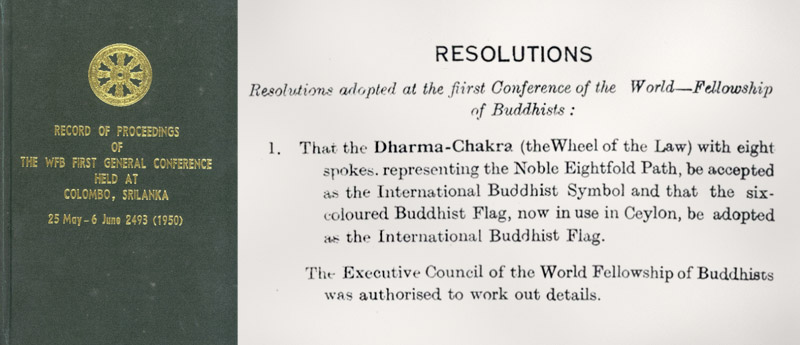
At the World Federation of Buddhists Conference in 1950, the resolution to adopt the six-colour Buddhist flag as the International Buddhist flag was passed.
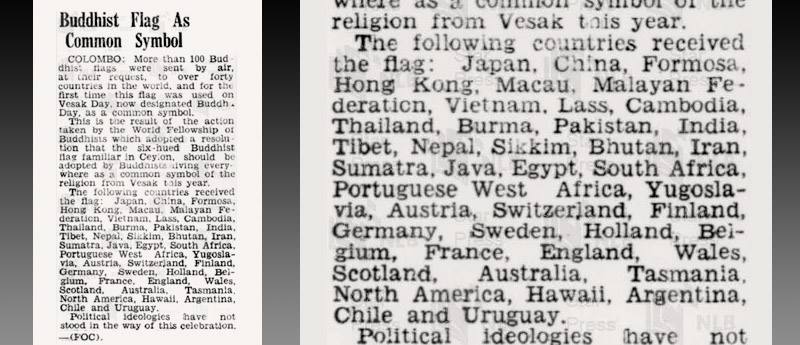
Indian Daily Mail, 24 May 1951, page 4, reported the historic arrival of the Buddhist flag in Malaya via air transport.
Another key figure instrumental in establishing the Buddhist flag as a symbol for the Buddhist world was Professor G.P. Malalasekera. His proposal at the meeting of the World Federation of Buddhists held in Colombo on 25 May 1950, advocated for its acceptance as the official Buddhist Flag. Subsequently, at the World Fellowship of Buddhists conference in 1952, the flag was unanimously adopted by international delegates as the universal symbol of the Buddhist faith. Since then, it has been prominently flown on significant occasions and at Buddhist events, particularly around Vesak Day.
Meaning of the colours of the Buddhist Flag
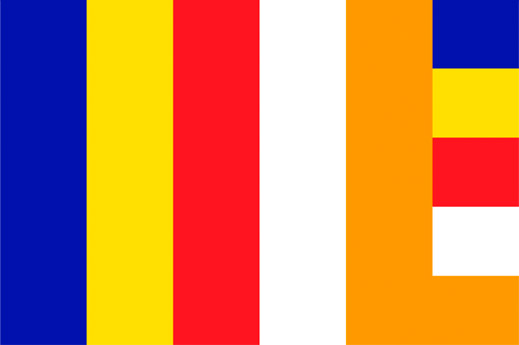
Let us explore the colours of the flag and their symbolic significance. The six vertical bands of the flag represent the colours of the aura believed to have radiated from the body of the Buddha upon attaining Enlightenment under the Bodhi Tree.
- Blue (Pāli and Sanskrit: nīla): symbolising Universal Compassion. The blue light emanates from the Buddha's hair.
- Yellow (Pāli and Sanskrit: pīta): signifying the Middle Way. The yellow light emanates from the Buddha's skin.
- Red (Pāli and Sanskrit: lohitaka): representing the Blessings of Practice – including achievement, wisdom, virtue, fortune, and dignity. The red light emanates from the Buddha's flesh.
- White (Pāli: odāta; Sanskrit: avadāta): reflecting the Purity of Dhamma – leading to liberation, timeless. The white light emanates from the Buddha's bones and teeth.
- Orange (Pāli: mañjeṭṭha; Sanskrit: mañjiṣṭhā – also known as scarlet): signifying the Wisdom of the Buddha's teachings. The orange light emanates from the Buddha's palms.
- The sixth vertical band, on the fly, comprises a combination of the five other colours' rectangular bands, representing a compound of these colours in the aura's spectrum. This new, compound colour is referred to as the Truth of the Buddha's teaching or Pabbhassara ("essence of light").
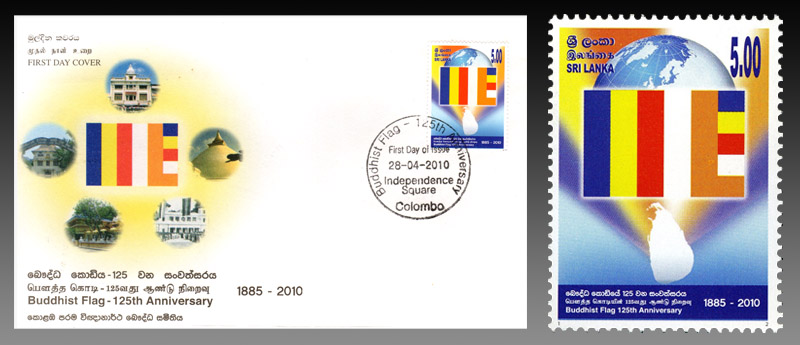
The 125th Anniversary Of The Buddhist Flag Stamp – Rs 5.00, Sri Lanka, 2010
The horizontal stripes symbolise the unity of the world's races living harmoniously, while the vertical stripes represent eternal world peace.
The "standard" Buddhist flag features blue-yellow-red-white-orange vertical stripes, each occupying one-sixth of the distance from the hoist. The sixth stripe (combination) comprises five horizontal stripes of the same colour, starting from the top. The right-hand vertical orange stripe merges with the bottom horizontal orange stripe.
The Buddhist flag: symbolising harmony and peace in Penang
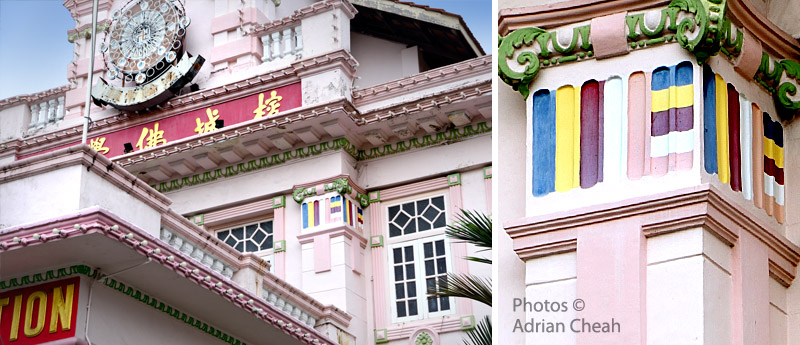
The Buddhist flag is etched into the pillars of the front facade of the straits eclectic building of the Penang Buddhist Association, which was completed in 1931.
In Penang, during the annual Vesak Day procession in George Town, the Buddhist flag carries great significance. As it is flutters through the streets, it represents not only devotion to the Buddha's teachings but also a commitment to fostering harmony among all races and striving for world peace. This tradition of the flag as a symbol of faith, unity and enlightenment echoes across Buddhist communities worldwide, guiding devotees on their spiritual journey. Let us all strive to allow our aura to glow brightly like the vibrant hues of the Buddhist flag, remembering to act with compassion and wisdom in our daily way of life.
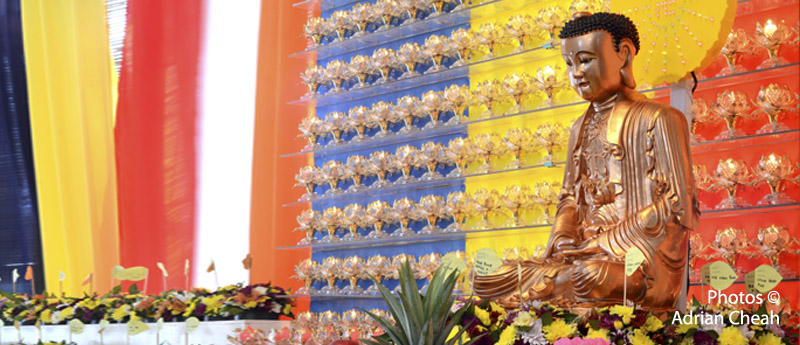
In taking time out to write this story, I had the opportunity to pause from work and daily routines, to delve into many interesting documents behind the Buddhist flag, such as the captivating life of Colonel Olcott. This process not only excites me but also serves as a way for me to learn more about my fellow men and the world we live in. It is clear that today, the Buddhist flag and its significance transcend geographical boundaries. From its humble origins in Colombo to its presence in Penang and beyond, the Buddhist Flag continues to guide devotees on their journey towards spiritual awakening and universal harmony.
-------------------------------------
Written and photographed by Adrian Cheah
© All rights reserved
13 May 2024